UNCOMMON BERRIES, FOR SOME
Note: If you live in a very hot summer climate, skip Part A and proceed to Part B.
Part A. Perfect for Ambulant Consumption
Part A. It’s about time that gooseberries got some respect. The plants are easy to grow, they tolerate shade, are usually ignored by deer and birds, except my ducks, and they can have excellent flavor. They don’t do very well or yield the tastiest fruits in hot summer climates, hence “Skip to Part B,” although the coolness of shade can somewhat overcome that deficiency.
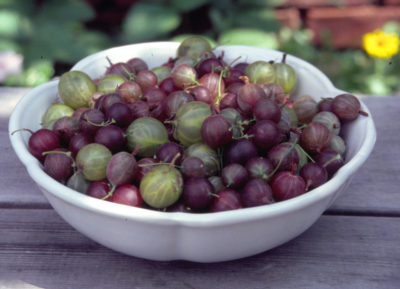
Gooseberry flavor is what eludes most people. And with good reason; relatively few of you have tasted gooseberries, let alone good-tasting varieties. The reason is that gooseberries belong to the Ribes genus, many plants of which are susceptible to a disease called white pine blister rust. This disease, also attacking white pines, need both white pines and susceptible Ribes plants to complete its life cycle.
When the rust showed up on American shores about 100 years ago, white pine was an important lumber crop so the U.S. government sought to control the rust be getting rid of all Ribes plants. Not only were gooseberries illegal to plant but if you already had gooseberries or currants, another Ribes species, in your garden, fellas from the Civilian Conservation Corps were apt to descent out of the woods into you garden to rip them out.
Long story short: Before the rust, gooseberries were an up and coming fruit, just like blueberries, which were relatively unknown except near where they grew wild. The ban was not as effective as was hoped. Disease could spread from the many wild Ribes haunt that our woodlands, and under the right conditions infective spores can be carried for hundreds of miles. On top of that, gooseberries and redcurrants are not very susceptible to the fungus.
The federal ban was lifted in 1966 and put under state mandate, but two generations of farmers and gardeners had forgotten about gooseberries. Relatively few states nowadays ban gooseberries.
Dessert (vs Culinary) Gooseberries
I once nurtured my own gooseberry variety collection of almost 50 varieties, a collection that now has been pared down to the most desirable dozen or so. I only grow what are known as “dessert” varieties of gooseberry, ones that have great flavor straight off the bushes. As Edward Bunyard wrote in his 1929 classic The Anatomy of Dessert, “The gooseberry is the fruit of course par excellence for ambulant consumption.”

This growing season has, so far, been one of the best fruit years ever, so I’m taking particular note of ripening time and flavor of my gooseberries. (Like a fine wine, though, they do seem to have vintage years.) First to ripen here is the variety Canada 0-273; its main qualities are that the plant is always productive and yielding large and early fruit.
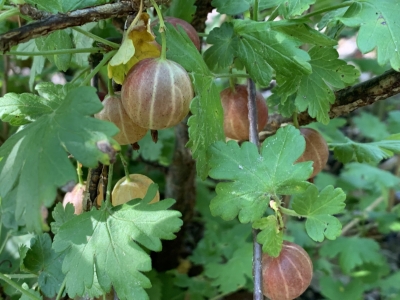
Canada 0-273 gooseberry
Next comes Poorman, an unfortunate name for a very delectable berry. Almost ripe now is Captivator, the variety I would grow if I were to grow only one variety. It’s delicious and pretty much thornless.

Poorman gooseberry
Soon to ripen are Red Jacket, very reliable and productive, with good flavor, and Welcome. Welcome is still with me for sentimental reasons; it was one of the first fruits I ever planted, decades ago, and has traveled with me to my gardens from Wisconsin to Delaware to Maryland to New York. It’s flavor is very similar to “SweeTart” candies.
Following the above varieties is another variety that would be on a must have list. Hinnonmakis Yellow is yellowish-green when ripe and has a flavor that hints of apricot. Some people confuse it with Hinnonmakis Red, which has poor flavor, and whose real name is, I believe, Lepaa Red. Also soon to ripen is Black Satin which has a rich, wine-y flavor.
That’s not all of them but does give you an inkling of the merits of the most significant ones. There are literally hundreds of varieties of gooseberries, spurred in part beginning in 18th century England, by gooseberry competitions, held usually in local inns, to see who could grow the largest fruits. The gaiety of singing and refreshments at these shows was offset by the solemn weighing of fruits.
Those gooseberries were bred strictly for size. I plant for flavor. Did I mention, pest problems of gooseberry? Powdery mildew and leaf spot diseases are potential problems but all the varieties I mentions are resistant to these diseases.
For more about the growing, the varieties, etc. of gooseberries, see my book Grow Fruit Naturally.
Part B. Some Mulberries are Better than Others
Part B. Some kind of mulberry can be grown just about everywhere. Here in the Hudson Valley, we have wild or cultivated red mulberries, which are native, white mulberries, most of which were imported from Asia in the early 1800s, and hybrids of the two. Don’t expect the color of a tree’s fruit, despite even the botanical names, Morus rubra and M. alba, to tell you what species you have before you. Many “white” (M. alba) mulberries or their hybrids bear black fruit.
To throw yet another wrench into the nomenclature, there’s yet another species, M. nigra or black mulberry, with black fruits. I consider black mulberry to be among the best-flavored of all fruits, not just mulberries. Unfortunately, it’s not hardy here. I grow it in a pot.

Black mulberry, M. nigra
Most years birds get just about all my mulberries; not this year, perhaps because of an abundance of other fruits. So I’ve been getting a good taste of them.
I find the flavor of most wild mulberries cloying. Not so for the two varieties I grow.
I, along with many others, have lent high praise to the variety Illinois Everbearing, often likening its flavor to that of black mulberries. This year I’ve reconsidered; Illinois Everbearing fruits are better than the average mulberry you might see growing in Eastern North America, but not nearly as good as black mulberry. Illinois Everbearing does live up to the “everbearing” in its name, yielding berry after berry for weeks on end.

Illinois Everbearing mulberry
My other variety is Oscar. It’s delicious, with a nice balance of acidity and sweetness.
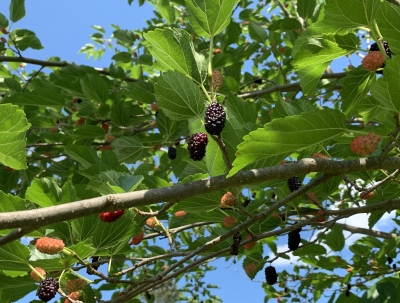
Oscar mulberry
Other years my impression of the two varieties has been different. Perhaps mulberries and gooseberries have vintage years that influence the flavors of particular varieties.
I actually grow one more variety of mulberry, Pakistani. This is yet another species, M. Macloura, that was once considered a kind of white mulberry. Pakistani, like black mulberry isn’t hardy here (probably hardy to Zone 7, perhaps colder) so I grow it in a pot. The fruit is delicious and large, sometimes as much as five inches long! My potted tree’s fruits are only an inch and a half long, but they’re as delicious as black mulberries. Different flavor though.
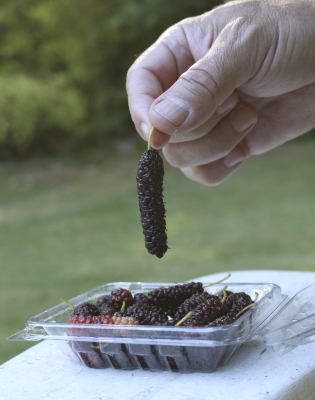

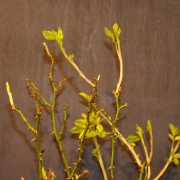
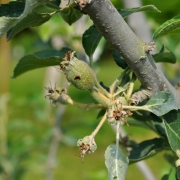
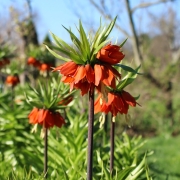
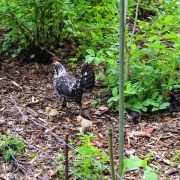

I had no idea that gooseberries had such a history. Can you recommend a good vendor and variety for zone 8b, Seattle ? Thanks
Raintreenursery.com. You can link to them right from their ad on my blog page. I know them and their plants well.
Hi Lee,
I love gooseberries and I grow the following:
Invicta, Poorman, Black Velvet, Jeanne, Jahn’s Prairie, Tixia, Captivator, Hinnomaki Yellow and Red. Invicta is tasty, but this year leaf spot has ravaged several bushes. I may remove those bushes. Do you grow Invicta? Where can you purchase Black Satin and Canda 0-273? Also, do you fertilize your bushes or use horticultural oil?
I don’t usually spray anything on my gooseberries but have chosen varieties with good flavor AND some disease resistance. I once grew Invicta but wasn’t alll that excited about its flavor. Not sure where I got Canada and Black Satin; I’ve had them for many years. They are disease resistant also.
I only grow two cultivars of gooseberries: Tixia and Hinnomaki Red. Contrary to what you said, I found the flavor of Hinnomaki Red to be exceptional. Tixia is also quite good but isn’t nearly as sweet.
Two other nice aspects of the Hinnomaki Reds: when ripe, they detach from the branch with barely a tug and, more importantly, they’re enormous. While many of the Tixia are a dime or less in diameter, the Hinnomaki Red are consistently a quarter or larger in diameter.
I should also say that I’m in zone 6B in VA and my bushes are planted in full sun, mulched with wood chips, and never watered or fertilized. They’re brilliant. They require virtually no care (other than pruning out an old cane or two) and produce gallons of berries that are excellent fresh, freeze well, and are amazing in pies and jams (particularly when paired with strawberries) and smoothies. I also like that they ripen after the black currants (and goumi) have already been picked.
Apart from the few you mentioned, are there other dessert varieties you would recommend?
Also, I have an Illinois Everbearing as well. The fruit is unlike anything I’ve ever eaten. It may be the perfect berry. I can’t begin to imagine how it would be improved upon.
Am I correct in thinking that mulberries can be propagated with softwood cuttings?
I agree with you about Tixia. I’m going to have to give Hinnonmaki Red another try. I last grew it many, many years ago. The very best gooseberries, in my opinion, are the British varieties, but they are very disease susceptible (powdery mildew especially) so I don’t grow them. I once grew Jumbo and Whitesmith, both of which were unbelievably delicious.
This year, at least, Oscar mulberry is far superior to Illinois Everbearing. Flavor of the latter is very variable this year, depending on the exact stage of ripeness.
Gumis galore this year!
Also, have you ever grown gooseberries as standards? If so, did you graft them on Ribes aureum or something else?
I’ve tried grafting on R. aureum but have never been successful. I have grown them as standards on their own roots, in which case the plants definitely need staking and sucker removal throughout their lives.
The sawfly larvae decimated one of my three red currents this year. Only way I’ve dealt with them is to hand pick them off and I didn’t do it this year. Any other suggestions for control? Is there a trap for current sawfly?
Many years ago, a had no sawflies. Then I had plenty, which I would control with a spray of horticultural soap especially down into the center of the plant as soon as I say them. Often ne spray would do the trick. For some reason, I haven’t had sawflies here for years. Luck? Eco-balance?
Hi Lee! I just picked up your book “Growing Fruit Naturally” and am excited to check it out. I have a jostaberry that is producing large amounts of fruit for the first time, and I’m not in love with the flavor. I’ll have to try some dessert type gooseberries next. I remember that you have a “Szukis” American persimmon. I bought one and planted it last year, but it has produced exclusively “male” flowers throughout the whole tree. I’ve learned that cuttings taken from male branches yield exclusively “male” plants, while cuttings from female branches can yield any combination of male and female flowers. Thought that might be useful info for you. Sxukis is definitely an odd one.
Do you still grow Invicta? I’ve been having tons of trouble with leaf spot on these plants, but the taste of these berries is excellent. What are the varieties that you grow beyond the ones you listed?
Invicta, no longer. Other varieties: Early Sulfur, Oregon Champion, Trixia, Resistenza, Red Jacket, Glendale, Hoenig’s Fruhest.
OMG what bliss I am in after reading this article! As you know, we grow (and eat) a lot of weird plants. By far our favorites are our black currents, which create our kitchen staple jam. Equal rank are our mulberries (but we are still trying to find just the right plant.) Our gooseberries are just now getting their rosy cheeks on here in upstate NY. The flavor of each of these really outranks our blueberries!
On another topic, I just spent the weekend down with a kidney stone. Haven’t had one in 10 years, but feeling oh-so-successful, broke down and made some sauce from our sorrel. Delicious. But no more oxalic acid for me, boo hoo! Be well!
This year’s gooseberries are history here on my farmden. It was a great year for them.
For me Hinnonmaki Red is great tasting and upright growing, so easy to pick. Hinnonmaki Yellow good too, but hardly apricot taste which is a bit of hype to sell it, nonetheless very pleasing plant to grow, but very thorny when picking as it spreads with a willow shape which makes it hard to pick fruits underneath. Captivator has a taste of jam and is sweeter than these two, but is lighter in yield-about 1.5kg on an established plant. The Hinno Red can be 2kg or more as the Hinno yellow and great for zones 3 to 8 needing 700 to 800 chill hours. Both large fruiting 5grams or higher, Captivator tends to be 3 to 4grams in size and well adapted in Zones 2 to 8, needing 800 chill hours.
I agree Lepaa Red is most likely exact cultivar as Hinnonmaki Red. Apparently named in honour after the Finnish plant station Lepaan which developed these great, tough plants. Nice web page! Thanks for the info.